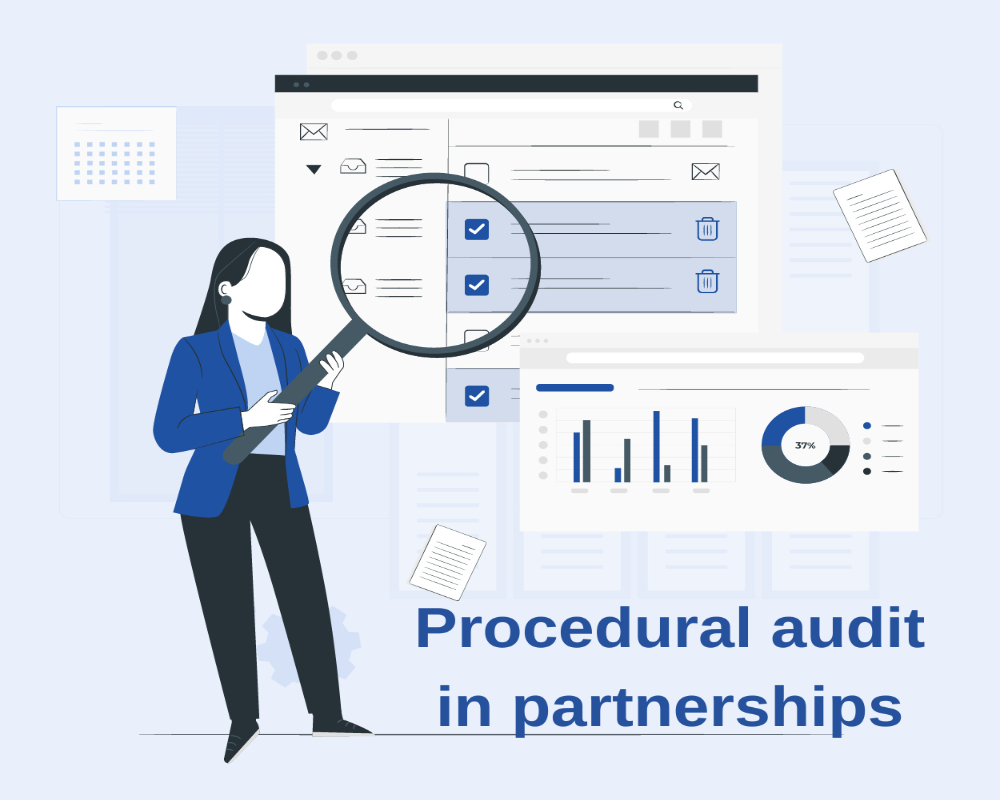Introduction
In a partnership firm, where business decisions and operations are carried out jointly by two or more partners, maintaining transparency, internal discipline, and accountability is essential. While financial audits focus on verifying financial accuracy, a procedural audit goes deeper into evaluating how well the internal processes, systems, and operational activities of the firm comply with the set policies, partnership deed, and regulatory standards. It is an important tool for ensuring that the day-to-day working of the firm aligns with best practices and predefined protocols. In partnerships, where trust and shared responsibility are fundamental, a procedural audit helps identify inefficiencies, prevent irregularities, and promote structured governance.
Meaning and Purpose of Procedural Audit
A procedural audit is a systematic examination of a firm’s internal procedures, workflows, and compliance practices. Unlike a financial audit that checks accounts and monetary transactions, a procedural audit evaluates whether standard operating procedures (SOPs) are being followed properly in areas such as procurement, payroll, documentation, partner roles, statutory filings, customer dealings, and inventory control. Its primary purpose is to:
- Ensure that internal controls are functioning effectively
- Verify consistency between practice and policy
- Detect procedural lapses, errors, or deviations
- Recommend improvements in operational efficiency
For partnership firms, a procedural audit reinforces the structure required to maintain order and reduce risk in shared operations.
Scope of Procedural Audit in a Partnership Firm
The scope of a procedural audit is broad and varies depending on the nature of the business. Key areas typically reviewed include:
- Compliance with the Partnership Deed
The audit checks whether partners are performing their roles and duties as defined in the partnership agreement. This includes reviewing capital contributions, profit-sharing arrangements, authority levels, and withdrawal rights. - Internal Controls and Authorizations
Auditors verify whether the firm has adequate controls for approvals, authorizations, and segregation of duties. For example, whether payments above a threshold require dual approval or whether bank transactions are being properly documented. - Procurement and Inventory Management
The process of purchasing goods and managing stock is evaluated to ensure transparency, adherence to budgets, and protection against theft or wastage. - HR and Payroll Procedures
Hiring practices, employee attendance, salary processing, and statutory deductions like PF, ESI, and professional tax are reviewed for procedural correctness. - Customer and Vendor Management
The audit checks how customer orders are processed, how invoices are raised, how payments are received, and how vendor contracts are managed. - Statutory and Regulatory Compliance
A key focus is whether the firm has complied with GST, income tax, TDS, and labor law requirements. Delays or lapses in these areas can lead to penalties. - Recordkeeping and Documentation
It assesses whether documentation related to financial transactions, employee files, agreements, licenses, and meeting resolutions is complete, organized, and accessible.
Benefits of Conducting Procedural Audits
Procedural audits provide several benefits to a partnership firm:
- Early detection of irregularities or inefficiencies
- Improved partner confidence in the firm’s internal management
- Better preparedness for external inspections or statutory audits
- Standardization of processes, reducing reliance on individual knowledge
- Strengthened internal governance and operational discipline
It also helps newer partners understand firm operations and offers a reference point for resolving conflicts based on procedural clarity.
Frequency and Reporting
A procedural audit can be conducted annually, biannually, or quarterly, depending on the size and complexity of the firm. The audit may be conducted by an internal auditor, an independent consultant, or a professional appointed by mutual agreement among partners. Upon completion, the auditor presents a detailed report highlighting:
- Observations of deviations or non-compliance
- Root cause analysis
- Recommendations for process improvements
- A corrective action plan and follow-up schedule
The report is usually discussed in a partner meeting and forms the basis for operational improvements or restructuring.
Conclusion
A procedural audit is a vital mechanism for partnership firms to evaluate and enhance their internal systems, ensure adherence to policies, and strengthen compliance frameworks. It serves not just as a control tool but also as a guide to optimize operations, reduce risks, and build accountability. By regularly conducting procedural audits, partnership firms can create a transparent and disciplined environment that supports sustainable growth, minimizes disputes, and fosters collective trust among partners, employees, and external stakeholders.
Hashtags
#ProceduralAudit #Partnerships #AuditProcess #Compliance #BusinessPartnerships #RiskManagement #QualityAssurance #FinancialAudit #OperationalAudit #PartnershipGovernance #DueDiligence #InternalControls #AuditStandards #Transparency #Accountability #BusinessIntegrity #Collaboration #PerformanceEvaluation #AuditBestPractices #StrategicPartnerships


0 Comments